Motivating employees is a crucial and challenging responsibility for management. However, it is becoming increasingly difficult due to downsizing, reorganization, and workplace diversity. This paper will examine how Chrysler engineering utilizes fear as a means of motivating employees, regardless of whether or not management is aware of it. It will discuss the issue of employee motivation.
The text will examine the problem by utilizing a variety of motivational theories. It will also employ a combination of theories to depict and implement strategies to modify the behavior of Chrysler engineers, ultimately enhancing their motivation. Additionally, it will offer an internal perspective on the functioning of motivation within the organization. Sadly, in 2008, the automotive industry suffered a collapse primarily caused by surging fuel expenses and the global financial crisis leading to the unfortunate loss of secure employment for numerous individuals, including autoworkers and engineers.
Both direct automotive employees and the indirect employees of businesses in the Detroit area are being hired back by Chrysler as a result of government-approved loans and the percentage sale to Fiat. However, employee motivation is a major issue for the company, which has been steadily losing its assets and resources since its sale to Daimler.
Employees are experiencing feelings of insecurity, unease, fear about their job situation, and a sense of being mistreated. The company faces a significant challenge in maintaining employee motivation, job security, and commitment. The overall atmosphere within the company can be described as depressing. Engineers specifically feel as though they are constantly under threat, like having shotguns attached to their heads, and they are anxiously awaiting someone to potentially pull the trigger for any reason. Regrettably, fear is currently the primary driving force for engineers.
Fear of unemployment persists, causing many employees to remain in their current roles until they secure alternative employment. Although management attempts to project a supportive image, their true actions contradict this facade. If one’s manager harbors dislike towards them, termination is inevitable. Employees solely seek a sense of security and safety in their workplace, fair compensation, and a connection to the organization beyond being perceived as mere tools by management.
According to Maslow’s Hierarchy of Needs, once the needs for safety and psychological needs are met, individuals seek love, affection, and a sense of belongingness (Prit, 2007). In addition, employees desire personal growth and to contribute to the growth of the organization. Lastly, there is a need for a work-life balance. To address the issue of poor motivation, managers must first determine why employees lack the proper motivations.
At Chrysler, engineers are provided with support and the necessary tools to perform their jobs, albeit sometimes at a slow pace. They have some freedom to carry out their tasks effectively. However, some employees experience a sense of neglect while others receive preferential treatment. There is a lack of recognition for successful completion of work, resulting in additional workload rather than praise. The absence of clear roles and responsibilities is highly frustrating and exhausting. Even when a promotion is involved, there is no established reward system in place.
Using a variety of motivational theories is necessary for managers to effectively inspire and engage engineers in the current workplace. It is important for managers to exhibit their own enthusiasm and motivation, as this will serve as a positive example for others. Conducting individual meetings with employees and collaborating with them to establish clear personal objectives that align with the organization’s goals is also essential.
According to Kinicki and Kreitner, “Not only do goals make us selectively perceptive, they also motivate us to act.” (Kinicki & Kreitner, 2009, 187). Managers should review goal progress during one-on-one meetings and help remove roadblocks that hinder employees from achieving their goals. According to an article on the website Changing Minds. org, “If other people set us goals without our involvement, then we are much less likely to be motivated to work hard at it than if we feel we have set or directed the goal ourselves.” (anonymous, 2010).
Managers should provide clear expectations for employees as they perform better when they have clear direction. To truly motivate employees, managers must understand what motivates each employee individually, and this can be achieved through one-on-one meetings and observation. It is important for organizational leaders to recognize that a successful motivation program should be ongoing and adaptable. As organizations evolve and employees change, the motivational program must also change in order to maintain its effectiveness.
The current motivational issue at Chrysler is clearly challenging. Employees are hesitant to make errors and are apprehensive about termination. Motivation based on fear is not a viable long-term solution. There is no singular optimal theory for motivating employees as they possess diverse personalities, necessitating a blend of theories. When devising a motivational plan, managers must incorporate multiple motivational theories. Such plans should be adaptable since the demands of the organization and employees’ needs are continually evolving.
References
Anonymous (2010). Goal-Setting theory. Retrieved January 06, 2011 from http://changingminds.org/explanations/theories/goals.htm
Kinicki, A. and Kreitner, R. (2009). Organizational behavior, skills and best practices (4th ed.). Boston, McGraw-Hill
Prit (2007, October 09). Employee Motivational Theories and Their Applications in Modern Organization. Retrieved January 09, 2011 http://bizcovering.com/business-nd-society/employee-motivational-theories-and- their-applications-in-modern-organizations/





